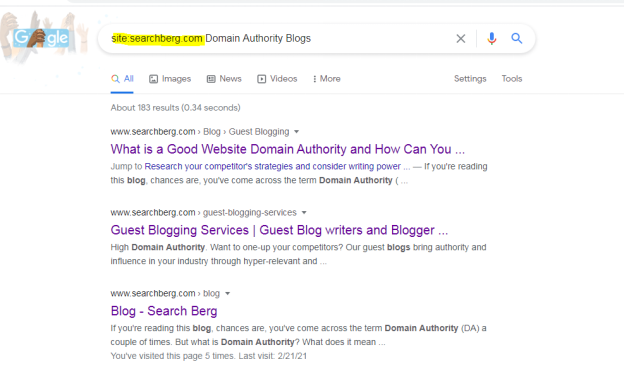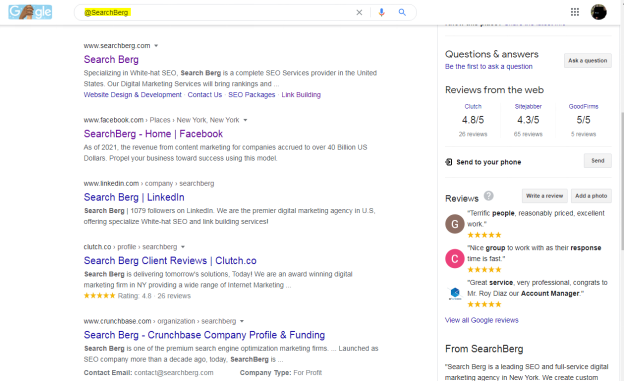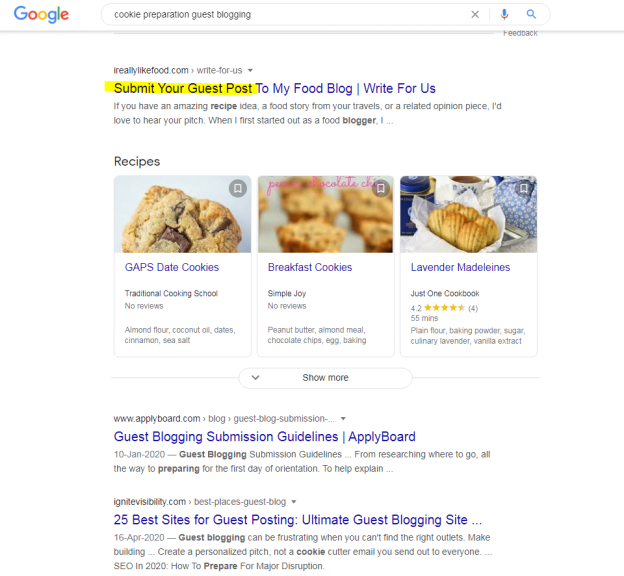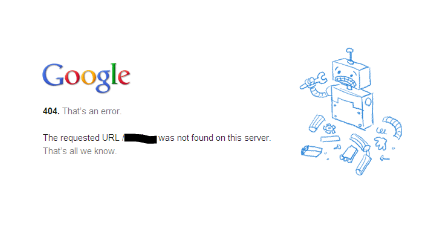A Guide To Off-Page SEO in 2021
In order to get people talking about your products and services, in order to get those calls and clicks, you need to be able to drive traffic on your website—organic traffic. This is basically free traffic that’s generated from search engines. However, how many ‘clicks’ your website gets is completely dependent on how well your website ranks.
An effective Search Engine Optimization (SEO) strategy is on-page and off-page SEO.
While On-Page SEO is a foundation, Off-Page SEO is the building itself.
In this blog, we will walk you through all the ins, outs, and Harry-Potter-like secret passage-ways of Off-Page SEO for beginners in 2021. Here, we talk about building that solid, 5-star structure on top of your optimized website to take it to the next level.
Let’s start by defining Off-Page SEO.
Sky-rocket your Off-Page SEO. Fill out the form below for results on your website!
Table of Contents
Off-Page vs. On-Page SEO: What’s the Difference?
Benefits of Off-Page SEO – Why does it matter?
- It Increases Your Website’s Rankings In SERPs
- It Can Immediately Boost Traffic In The Form of Referral Traffic
- It Builds Website Authority Through The Nod-Of-Approval Effect
- It Helps You Build And Promote Your Business
- It Helps Increase Your Social Media Presence
How To Do Off-Page SEO: Step By Step Instructions
- Understand Off-Page SEO Ranking Factors
- Using State-Of-The-Art Off-Page SEO Techniques
- Collaborate with Influencers
- Guest Post Like A Boss
- Find Broken Links
- Market “Valuable” Content
- Take Part in Forum Discussions!
- Answer Questions on Q&A Websites
- Use Blog Commenting To Your Advantage
- Create Infographics and other Value-Adding Content to Build Backlinks
- Keep Up with Your Backlinkers and Even Give Back
- Transform Unlinked Mentions into Backlinks
- Use a Newsletter and an Email List
What is Off-Page SEO?
Off-Page SEO encompasses all the tasks you do outside of your own website to promote it and build its ranking and traffic. Also known as “Off-Site SEO,” Off-Page SEO improves your site’s relevance, reputation, popularity, trustworthiness, and authority in the eyes of the users and search engines.
A lot of small businesses make the mistake of believing that off-page SEO is all just about building links. Wrong. It involved a range of techniques and activities (some of which we’ll be discussing ahead) directed to increase your website’s DA and ultimately, its rankings and traffic.
Off-Page vs. On-Page SEO: What’s the Difference?
You may have already gathered this, but On-Page SEO encompasses everything you can do on your site to improve your site’s rankings.
[table “2” not found /]
We’ll get into a more in-depth discussion regarding Off-Page SEO techniques further within this blog.
Your goal with Off-Page or Off Site SEO is to influence your site’s rankings, relevance, popularity, and trustworthiness.
Struggling with low website traffic? Fill out the form below and let’s get started with SEO that makes an impact!
Benefits of Off-Page SEO– Why does it matter?
You might now be wondering why and how Off-Page SEO can help you influence your site’s rankings, relevance, popularity, and trustworthiness.
Well, there are some key strategic advantages and benefits of implementing Off-Page SEO that you should know in order to keep your efforts streamlined.
1. It Increases Your Website’s Rankings In SERPs
Search engines evaluate content based on relevancy and links. Solid, relevant content is key and links. Link evaluation is what helped Google, as a search engine, to stand out and thrive. It started with this paper published by the cofounders of Google at Stanford.
Why would a website link to another website if it directs its viewers away from their own site? To provide value to a user via a relevant third-party link.
Therefore, these links are like votes of approval, telling Google: “This is one of the good ones—let them into the club. “The symbolic “club” in this context is naturally a higher ranking on Google’s SERP.
2. It Can Immediately Boost Traffic In The Form of Referral Traffic
Off-Page SEO increases your rankings on Google but it also directly increases your website’s traffic. This is because you have built a new source of continuous traffic.
When your Off-Page SEO activity is fresh, such as a newly published guest post linking to your website, your traffic flow may increase exponentially. Eventually, it will level out, but it will continue to bring your site consistent traffic as long as the referring website is functional and up-to-date.
3. It Builds Website Authority Through The Nod-Of-Approval Effect
Google evaluates your website’s Page Rank and Domain Authority factors (to determine your site’s ranking) using a system. In this ranking system, the sites that get the best quality and quantity of relevant sites linking to them are ranked higher in search engine results.
Why does this happen?

This happens because of the “nod of approval” effect we discussed earlier in the first benefit of Off-Page SEO.
In more technical terms, the site that links to a third-party website (yours) will pass on some of its Page Rank and SEO juice to the site it is linking to.
4. It Helps You Build And Promote Your Business
With Off-Page SEO practices and techniques, you can use certain platforms to showcase your brand personality and message. Helping users understand why you do what you do can help them decide whether their interests align with your business.
Showcasing your brand’s personality also helps you to attract users and customers that you ideally want to work with.
5. It Helps Increase Your Social Media Presence
Social Media and website traffic feed into each other. Increases in traffic resulting from Off-Page SEO practices result in higher social media following and engagement, which leads to higher website traffic and conversions.
How To Do Off-Page SEO: Step By Step Instructions
Understand Off-Page SEO Ranking Factors
As a whole, SEO is dependent on 3 key factors: ART.
These are Authority, Relevance, and Trustworthiness. So when you want to consider Off-Page SEO ranking factors, it’s useful to remember that all the factors we will discuss work because they contribute to the overall ART factors influencing SEO.
Under the larger umbrella of Off-Page SEO, there are two main categories that traffic building practices fall under. These are Link Factors and Non Link factors.
Link Factors
The key to Off-Page SEO is to build reputable backlinks.
The quality of your backlink depends on many factors. These include:
1. The Linking Website’s Relevance to Your Website and Niche
Since Google’s BERT update, there has been an emphasis on relevance and matching search intent in Google’s SERP. So if your site is linked on a page that isn’t relevant to your niche, website, service/product, it likely won’t give your site the SEO nectar you are seeking.
Without relevance, this SEO nectar might instead be crude oil.
2. The Website’s Consistent Traffic Flow—Whether it’s High, Medium, or Low
A website’s traffic is good for two reasons. Firstly, it provides your site with plenty of referral traffic. If they approve of and endorse you to their existing audience, their existing audience will be more inclined to follow your business and journey.
A high consistent traffic flow also means the website must have good SEO or internet presence somewhere, which also boosts your site’s SEO.
3. How Fresh Are The Backlink—is it Still Relevant?
For example, if your link was in a blog post that expired or the owner has let their site’s web rankings go to hell, it might be more beneficial to cut your losses and disavow that link.
4. How Many Additional Links the Web Page Linking to Your Site Includes
When you’re building a backlink with a website, it’s important to go through the site’s content to estimate how many more businesses they provide with backlinks. Check the backlink numbers relative to the word counts.
When one paragraph contains one link, users are more likely to click on it. But if one paragraph contains multiple links, users are significantly less likely to click on them.

Multiple links in a paragraph, therefore, make the link you build less clickable.
Also, if the multiple sites linked are your competitors, then that is yet another red flag.
For further information regarding ideal backlink quantities, check out our blog Backlink Quality vs. Quantity: What’s More Important in 2021?
5. The Linking Website’s Rank and Domain Authority
Put simply, if the site linking to yours has SEO juice, to begin with, it will pass on that juice to your site. SEO juice includes a solid current rank and Domain Authority.
In turn, your own website’s Domain Authority will also improve, which makes ranking for keywords on new pages from your own site faster.
To learn more about improving your Domain Authority, check out our blog What is a Good Domain Authority and How Can You Increase Yours.
Non Link Factors
These factors influence the strength of your Off-Page SEO efforts outside of traditional link building.
Non Link Factors include:
1. Unlinked Mentions
This would mean hashtags, casual mentions of your brand on social media and in blogs/other web pages. You can find these using Google’s Advanced Search options.

Using these hacks, you can even search through social media using Google.

2. Social Media Presence
A business’s goal, when using social media, should be to redirect traffic from its social media pages back to its website. So while it’s not a traditional backlink on a webpage, it still drives traffic and improves SEO.
While some argue that social media does not affect SEO, high Domain Authority (which measures a site’s ability to rank quickly on Google) is correlated with a good social media presence.
Also, not having social media in the digital age is equivalent to not having a business card. It is an essential platform to engage with your target audience directly.
Your key social media factors are those that affect how likely users are to click on a link you provide them. In a nutshell, this means one thing: user engagement rates.
How receptive are your followers to the new content that you put out? Do they value the posts you already share? Do you have conversation threads starting in your comments section? Do they actively ask you questions and participate in polls/challenges/competitions that you run?
An engaged audience is an excited audience. An audience is excited because they see value being provided to them. Therefore, an engaged audience is more likely to convert into a paying customer.
3. Influencer Marketing
When you’re working with influencers, remember that quality is more important than quantity when it comes to their audiences. While it may be tempting to reach out to simply “popular” influencers, it will be more cost-effective and yield higher returns for your business if you focus on targeting influencers within your niche.
Even if they have a relatively average audience size, as long as their followers are interested in what your product/service will be able to offer them, you’ve got a match.
We’ll discuss the ins and outs of influencer marketing for your Off-Page SEO further in this blog, but for now, know that relevance matters more than fan following sizes.
Using State-Of-The-Art Off-Page SEO Techniques
Once you understand the ranking factors influencing your Off-Page SEO, your next logical question would be: how do I put this into practice?
To help you practically build your Off-Page SEO, we’ve compiled the following actionable techniques that have proven results.
1. Collaborate with Influencers
You can coordinate with influencers by targeting them based on your content. Say, for example, that you just released a blog post about prepping cookie dough just right before baking.
To find a relevant influencer, it’s not enough to just find a famous chef with a devoted following, but one who specializes in baked goods. If they specialize in cookies, particularly, then that’s even better!
Link it to them and ask them for their opinion on the piece. Once they agree and have shared their thoughts on your site, you can highlight that comment on your website as a quote. You can also reach out to them prior to publishing it to get their opinion. In the blog itself, you can highlight their point of view in a relevant quote.
It’ll be even more enticing for the influencer if you ask them for their expert opinion on a contentious debate topic.
As a completely arbitrary example, say that bakers on the internet often argue about whether the ideal temperature to prepare your cookie dough under is either 72 degrees or 82 degrees.
A useful tiebreaker for your blog would be to consult an expert in the field (i.e., the influencer) to settle the debate for the purposes of your blog by putting their two cents in.
Once you do publish the blog, you can ask the influencer to share the piece with their network. Typically, this would result in a few social media shares from their account, which would link to all of their followers.
Using this tactic, you not only further your site’s authority by consulting and quoting a well-known expert in the field, but you also get a ton of traffic.
2. Guest Post Like A Boss
Many struggle with finding a guest posting opportunity, but it’s really not challenging when you know what to look for.
Identify the target keywords that you want to rank for, then look up key terms like “contribute for us,” “write for us, “and “guest blogging opportunity.”

Instead of using your keyword specifically, you can even just look up guest blogging opportunities within your niche on Google and then pitch whatever content idea you want to write about.
Your content idea should be based on the keywords you want to target. Your topic should be relevant to your expertise, i.e., whatever service or product you are offering on your website to make revenues.
When your guest post topic provides value, and it’s similar in category to what you deal with and discuss on your own website, it’s only the natural next step for viewers of your guest post to go to your website.
The means through which these users transport from the guest posting website to yours is a link you will place in your Author Bio at the end of your guest post, along with a helpful blurb about what it is you do and how you help the types of people that would read about your blog topic.
3. Find Broken Links
Broken links on a website are a result of faulty linking, expired links, expired domains, etc.

The point is the link does not work and provides a poor user experience. It puts a bad taste in a user’s mouth when they click on a relevant-seeming link, but it’s not working. It also reflects poorly on the linking site.
But where there are broken links, there is an opportunity.
In sites relevant to your website that have posted links to content similar to yours, see how many of those links work. It will be a trial and error process, or you can invest in some link analyzing software and do it faster.
The idea is: find broken links and reach out to the website owner to tell them about it.
When you tell them that a specific link of theirs is broken, this is your opportunity to suggest your relevant link for the owner to switch their broken link out with.
4. Market “Valuable” Content
Content Marketing is an insanely powerful marketing tactic. In 2021, it crossed $40 Billion in revenue for companies.
So clearly, it’s important on its own. Marketing valuable content to your audience is key. But did you know that you can enhance your content outside of your website (Off-Page) and use this enhancement to improve your SEO?
Google owns many different properties. So out of all the different websites on the internet, Google naturally has a preference for its own properties and rewards those that use and link multiple Google properties together.
This reward is in the form of higher rankings on Google’s SERP.
For example, Google owns the video-sharing giant YouTube.
So if you have already posted a blog about, say, the right way to water your hydrangeas, then you can also create a YouTube video on the same subject.
Once you’ve made the video, link it to your web page and use your web page to link back to your YouTube video (embed it).
So because the two link to each other, in Google’s eyes, you’ve linked two of their properties together by using both platforms for your business.
As a result, Google will reward your website.
In regards to the video—even if you’re just starting out, you can make a video using screen-recording software and a PowerPoint presentation covering the same points in your blog.
This process can take you as little as 15 minutes to record the video and link both your blog and YouTube video to each other.
Of course, the higher your video’s quality, the more engaged your viewers will be.
But for the purposes of Off-Page SEO, you’ve done your job by linking the two properties.
To help you better understand how you can take full advantage of video marketing, check this out:
You can repeat the same link building exercise for your business’s web pages between Google’s many other properties such as Google My Business, Google Plus, etc.
5. Take Part in Forum Discussions!
In order to effectively use this Off-Page SEO technique, you need to locate and take part in discussions related to your products/services/niche. Connect with the community in your niche, provide them with value, and put your two cents as a professional in the field.
When you’re creating your profile, it’s important to include a hyperlink in your bio or profile information that leads back to your website. That way, each time that you comment, the link shows up and provides a new valuable backlink to your website.
A hack here is to seek out websites that specifically allow you to use do-follow links as opposed to no-follow ones.
You want the search engine to be notified each time you post a comment in order to improve your Off-Page SEO, so you need to make sure that the link in your profile will be a do-follow link.
6. Answer Questions on Q&A Websites
On many websites like Quora, Yahoo, etc., there are users in your industry who have questions relevant to your products and/or services. The key is to find these questions, provide them with value-adding answers, and only link to your website when it is relevant.
In your profile, make sure to write about what you do and add a link to your website. This way, you get to meet your target consumers at the grass-roots level and help them by providing impactful answers to their concerns and questions.
7. Use Blog Commenting To Your Advantage
Blog commenting is a controversial practice because it can be manipulated as a black-hat SEO Strategy. But major brands use this technique to improve their rankings without using the infamous keyword stuffing practice.
You can still use Blog commenting to build Off-Page SEO for your website. You just need to do it in a way that provides value and links your website where it is relevant.
How do you do this?
Well, you start by finding relevant blogs and topics and then writing a value-enhancing blog comment. In this comment, you can include a link to a highly relevant blog you may have written on the subject matter or debate at hand.
When uploading comments to a reputable blog, it can help to make your profile as legitimate-looking as possible. Include your full name, a working email address, and perhaps even a picture of yourself in your profile so that the blog owner is more likely to approve your comment.
When you establish yourself as a consistent, high-value commenter, many of the bigger blog owners will even be tempted to check out your website and leave a comment on your blog.
In this way, blog commenting is a gateway to building high-profile relationships in which a larger blogger and yourself can provide each other with mutual benefit.
8. Create Infographics and other Value-Adding Content to Build Backlinks
Another way to build Off-Page SEO is to provide value to existing blogs within your niche. This could look like creating an infographic, graphic, bar-chart, or even compiling a helpful statistic that would help enrich a blog whose website you’re seeking a backlink from.
Ensure that the topic you target is relevant to your business’s products/services and the niche that the site itself is in.
The last thing a baker needs is to show up on a page about hair gel, for example.
So do your due diligence in this regard. Instead of creating content that just restates what the blogger is already saying, focus your efforts on creating content that improves the quality of the blog.
For example, if the blog discusses a complex topic, to help its readers better understand it, you can create a helpful infographics explaining the concept.
Here’s a good example of an infographic we made that you can take inspiration from and mold yours after.
Therefore, because your content helps the blogger’s target readers, they are more enticed to accept your content and add it to their blog.
If they choose to use your content, you can discuss them linking to your site in your communications with the site owner.
You can also get creative with this approach in terms of how you add value. Your content can even be a video animation, a gifset, a comic strip (depending on the blog’s niche), etc.
9. Keep Up with Your Backlinkers and Even Give Back
You can use free and/or paid backlink tools to track which websites are linking to your website. For your reference, you should create and keep an updated list of websites that are linking to yours because they are helping out your rankings and traffic flow.
It’s key to keep a list because it’s possible that websites that may have linked to your site in the past may stop doing so without warning.
In cases like these, because you have your list to refer to, you know which backlinks disappeared and which ones are new.
So in the case that a website stops linking to yours, you can actually reach out and respectfully inquire what happened and why they stopped linking to your website.
Specifically reaching out to them in this way can and has proven to reinstate your backlink on their website, provided you handle it well, and there aren’t unrelated, third-party reasons that they chose to remove your link.
You can and should also get familiar with backlinks even if they keep your link up. Getting to know about their business and why they linked to your site can play a key role in building a good business relationship with the site owner/s.
When relevant in your blog, you can even provide them with a backlink, thereby continuing that business relationship by also providing them with value.
As time passes, having a good relationship with each of your backlinking partners can help propel you towards even greater online success.
10. Transform Unlinked Mentions into Backlinks
We mentioned unlinked mentions previously in this blog as a non-linking factor. They are helpful because they build brand awareness and indirectly increase traffic, but they are no comparison to a linked mention.
A linked mention is more valuable for your Off-Page SEO because it’s a URL that viewers can click to transport to your website. Hence, it builds greater traffic for your site.
Between linked mentions, a do-follow link will provide your site with greater SEO juice than a no-follow link.
But getting back to transforming your unlinked mention: the first step is to find your unlinked blog or website mentions using the techniques listed previously. Secondly, you want to reach out to the website owner/s and request that they link your website where they have mentioned product/services.
Transforming unlinked mentions in this way can be a powerful step to improve your Off-Page SEO, especially in the case that a high domain authority (DA) blog mentions your website.
Take full advantage of the opportunities you currently have with unlinked mentions.
For even further in-depth techniques on building backlinks, check out our blog 10 Advanced Link Building Tips And Tricks To Boost Your SEO.
11. Use a Newsletter and an Email List
Newsletters and email lists are incredibly valuable because you own them.
A problem with social media is that it can be unreliable and even shut down completely.
For example, if you post on social media, your content will go on a dedicated user’s newsfeed, where out of many posts, they might miss yours entirely.
Instagram and Facebook also notoriously don’t display all posts put up by users to other users following them, even if the user put it up recently.
In addition to not showing your content to all your followers, social media can also shut down due to reasons outside of your control.
The most salient example of this phenomenon is that of the video-sharing platform Vine, which shut down in October 2016.
Many Vine creators, AKA “Viners,” relied on the traffic they got from Vine as a source of income. So when Twitter unexpectedly shut down the Vine application, many business owners were rightfully distraught as they watched their audience slip away.
Unlike social media, email lists are permanent, and you can download your list as an excel file as well as move it to different email marketing platforms with ease.
Firstly, it’s permanent and reliable to use email marketing to engage with your audience and customers. Secondly, emails are much more likely to be seen in an inbox over posts in a massive, constantly-refreshing newsfeed.
Therefore, open-rates for emails are high and bring greater conversions for business owners relative to social media alone.
To incentivize your email list subscribers, you can even offer exclusive discount codes and resources that they will appreciate if they’re subscribed to your email list or newsletter.
Now, you can keep your business’s audience with you regardless of how big corporations decide the fate of various social media platforms.
12. Piggyback Your Success With Highly Experienced Professionals
While it may be enticing to learn everything you can about digital marketing and optimizing your off page SEO yourself, it’s important for you to ask yourself if your time is better spent elsewhere.
This could be creating content, perfecting your services and products to meet your customers’ needs, and more. Digital marketing and SEO professionals, especially companies, have tons of experience and can make the whole process of getting leads, conversions and sales through both SEO and paid advertising incredibly streamlined.
This ultimately frees your time and mental energy to focus on what really matters to you in your business outside off page SEO.
Wrapping Up!
There you have it! The Off-Page SEO guide every business owner should have. You now understand the benefits of working on this aspect of your website’s SEO, the most significant link and non-link factors that influence Off-Page SEO, and some killer techniques to boost your ranking and traffic for your targeted keywords.
Off-Page SEO requires time and a diligent trial and error process. Here at Search Berg, our Off-Page SEO Specialists use state-of-the-art software, years of cutting edge experience, and innovative strategies to help your business thrive in the world of Off-Page SEO and beyond.
Call us at 855-444-4777to improve your Off-Page SEO and boost traffic and conversions on your website now!












